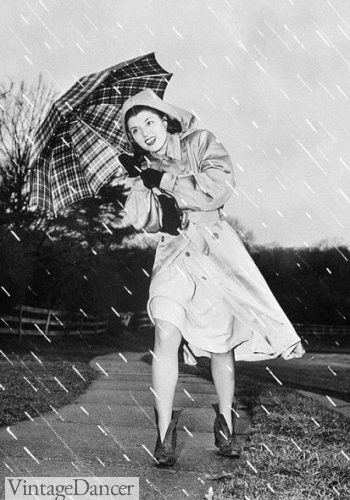
1940s trench raincoat, rubber galoshes, and plaid umbrella
Reader Karin asked a great question: What did women wear in very wet climates? With all my research on warm winter coats and boots, I neglected to talk about the difficulty of staying dry in rainy weather. Turning to my favorite vintage source, catalogs, I found a wide variety of wool coats and fur-lined boots, but only a few options for waterproof vintage raincoats or rain slickers, rain hats, and umbrellas. Hmmm, it seems that staying dry wasn’t nearly as sellable as staying warm and fashionable. Or, perhaps it was because a thick wool coat did a pretty good job of providing both warmth and dryness, except in extreme rain.
Let us do some singing in the rain and dance our way through the vintage history of women’s raincoats and rain hats from the 1920s, 1930s, 1940s, and 1950s.
1920s Rain Slickers
The turn of the century introduced a new technique of rubberizing fabric that was soft and pliable and ready for use in clothing. It didn’t breathe well and was prone to deterioration from natural body oils, but it was better than wearing a stiff rubber slicker or heavy oilcloth. The rubberized cloth was usually sewn with a top cloth, like a lining, of wool or cotton. In the ad below, Bombazine, a cotton fabric with a rubberized inner surface, was used for making raincoats and rain hats. It came in both a smooth and textured finish, with the latter being like tweed or spun wool. These raincoats or rain slickers mimicked the coat fashion of the time – longer length, loose belt, high roll / convertible collar, and large pockets. The matching hats were shaped like a mop cap or shower cap with a turndown brim. Popular 1920s raincoat colors were tan, navy blue, and grey.
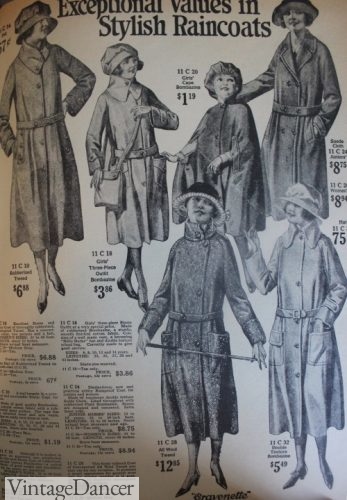
Early 1920s raincoats with hats
The rain cape was another waterproof style for women and children. In the ad below, a child wears the rain cape with attached hat. The cape wrapped around the body and buttoned up the front with two slit holes on either side for the arms.
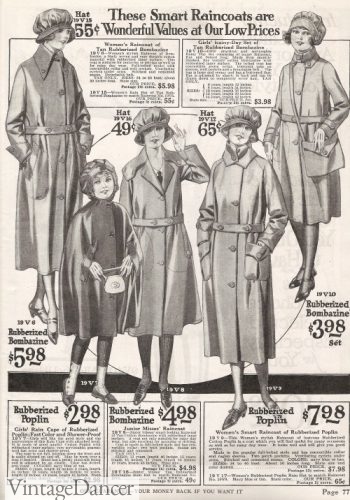
1922 raincoats and caps
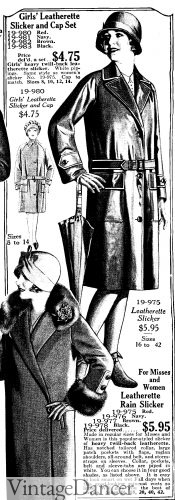
1928 leatherette rain coat
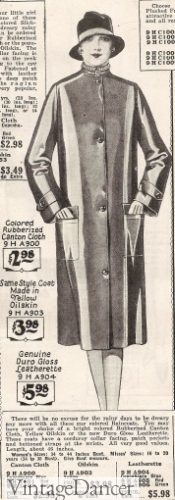
1927 rain slicker
In the mid to late 1920s, we see more variety of cloth offered in raincoats. Canvas cloth which was not rubberized but generally water repellant was borrowed from menswear and adapted for women. Oilcloth, too, was adopted as a better but very heavy alternative. Then there was glossy leatherette, which I believe was just rubber (looks like vinyl). The one above is quite modern for the times. “Made of heavy twill leatherette. Piped in white. You can choose four good shades: Red, Navy, Brown, Black.” The new bold colors and white trim make it very mod indeed. Other colors from the era include yellow, green, and gas blue.
Rain hats adjusted to the changes in women’s hat fashion. The mid ’20s rain hat was now shaped like a cloche, with a wide fold up brim that could also snap down for more protection. With an umbrella there wasn’t much need for a separate rain hat, because the all wool felt fashion hat was quite rainproof already.
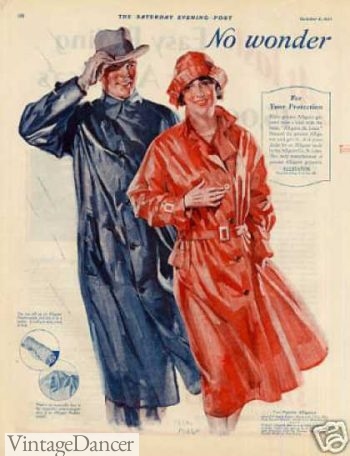
Mid 20s Red raincoat with matching cloche hat
1930s Raincoats & Capes
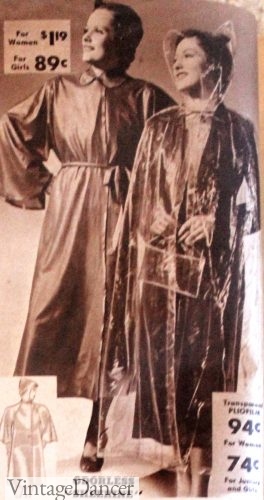
1930s wrap over rain cape with belt and clear raincoat with matching bag
In the 1930s, the rain cape was the preferred waterproof cover. This was largely due to the poor economy during the depression. Not needing to buy an expensive separate raincoat and only wearing a light repellent rain cape was very economical. The cape was long, worn down to the ankles, and wrapped instead of buttoned, securing with a thin rubber tie belt (optional). Some capes had attached hoods, while others had large round collars that echoed dress collars worn underneath. Most raincapes did not have sleeves or arm holes like they did in the 1920s. Colors were still bright: red, brown, natural (tan), medium blue, medium green, and white.
The slip over rain jacket did have sleeves and also came in translucent materials. This new see-through raincoat was just the thing women needed to show off the beauty of their clothing underneath. Raincapes and coats were sold with a pretty silk oiled envelope bag to fold up and stash away upon going inside. The clear coat on the right also came with a clear bag with handle.
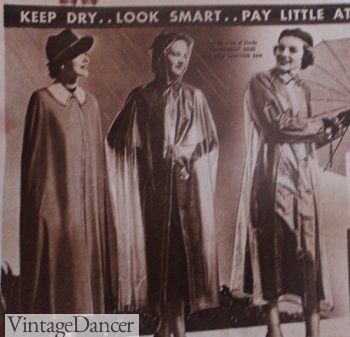
1930s raincapes
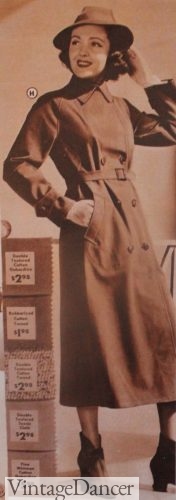
1930s polo raincoat
By the end of the decade, the economy was improving and women returned to buying raincoats that looked exactly like fashion coats. The polo coat was an especially popular design. It later became the trench coat with double breasted front, wide belt, side pockets, and storm stops on the wrists. Many coats were not rubberized. Instead, they were made from tightly woven cotton cloth in a variety of textures like suede, tweed, nubby cotton, and the most famous gabardine. Gabardine went on to dominate men’s and women’s coats and jackets in the ’40s and ’50s. Light and flexible yet generally water repellent, it didn’t replace a rubber rain cape in bad weather, but for general wear it was a good choice. Colors for these more fashionable coats were navy blue, gray, medium brown, and tan.
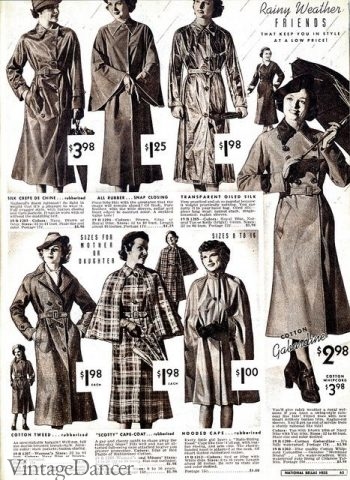
1930s raincoats and fashion coats
The 1930s coats in the above picture were rubberized polo coats. They came in all rubber, crepe de chine, oiled silk, and cotton tweed. I love the plaid coat with the over cape and matching umbrella. Notice the raincape with arm holes came back in fashion, too.
With the exception of hooded capes and raincoats, there were no special rain hats featured in any of my catalogs. There probably were some, shaped like a jaunty fedora just like they were in the 1940s.
1940s Raincoats
New inventions during and after the war led to new treatments for waterproofing fabrics. I don’t know exactly what these treatments were (textile production is not my area of expertise). The catalogs just refer to “treated” or “coated” waterproof fabrics. However, most 1940s raincoats were made of cotton gabardine. They were mostly turned into rain capes or simple utility coats with padded shoulders, wide lapels/ collars, and big belts, altogether forming the typical masculine/military shape. Hemlines rose to just below the knee (their legs must have always been cold and wet) and colors dulled down into drab military hues. What was remarkable about the 1940s was that the new coat styles that emerged during the decade have stayed with us ever since.
Utility Coat
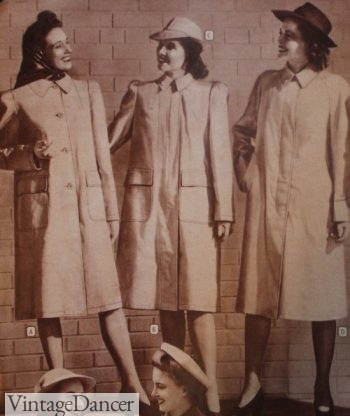
1940s utility raincoats
The utility coat, also called a shop coat, was a straight fitting coat with button or zip front that was usually hidden behind a fly for maximum weatherproofing. They buttoned up with a high round collar and had two very large flap or slit pockets on the sides. They came in neutral colors (namely army tan) or grey and were otherwise not very pretty, just practical.
Trench Coat
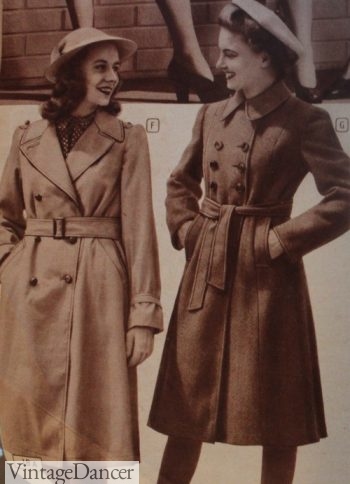
1940s trench coats
The most iconic of all 1940s raincoats was the trench coat. It was a direct copy from men’s military coats with very wide notch lapels and a convertible collar, wide belt plain with rectangle metal buckle, epaulets on the padded shoulders, deep side pockets, and two rows of buttons on the double-breasted front. Men’s raincoats looked almost exactly the same. Colors were limited to tan (fawn), navy blue, and sometimes black.
Wrap Coat
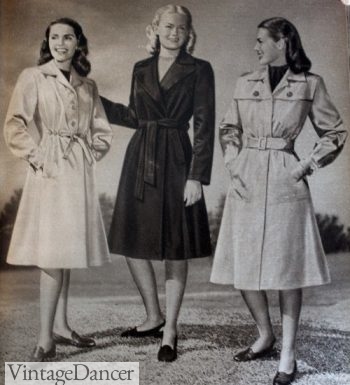
1940s rain coat; (middle) wrap coat in black, (R) trench coat, (L) semi trench box coat
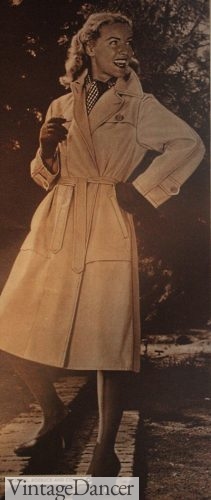
Mid 1940s wrap raincoat
The most feminine 1940s raincoat was the wrap coat. Single breasted with wrap over sides, it tied instead of buttoning or zipping. It had wide notch or peak lapels, or high round collar. Slash pockets on the sides minimized bulk, keeping this jacket streamlined and dainty. It wasn’t a very good option for heavy downpours, but for light to medium rain it was a good choice. It was usually lined in cotton or another soft fabric in a bold pattern like plaid. It came in cotton or rayon gabardine or a treated shiny “paratroop” twill rayon for more waterproofing. By the end of the decade, it was offered in more colors like medium blue, black, Air Force blue, gray, bright green, brown, or natural.
Sometimes, these were called box coats, which was a general name for most ’40s coats. They could have buttons or not, pockets or not, a belt or not. Combining some of the elements from each of these classic styles formed an array of new “rain or shine” coats, perfect for staying dry in spring showers.
Rain hats. Just like the ’30s, 1940s rain hats were rare. The only one made for rain was the pork pie hat, sold as a matching set with a rain jacket. It had a long forward brim with a smaller curled brim at the back and sides. Similar winter hats were made of wool felt in the shape of tams, bonnets, and fedoras. They each featured a visor front to keep the rain off. Non rainproof winter hats were the kerchief or headscarf, knit “parka” beanie, wrap turban, or wool beret. Learn more about 1940s hats here.
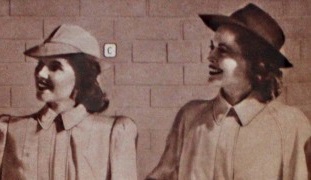
1940s rain hats
1950s Raincoats
In the 1950s, the trend for raincoats in the trench style continued. The ’50s version featured more pleating at the back of the jacket to accommodate the full swing skirts and dresses of the decade. They also came with matching caps, similar to a short brim baseball cap. The material was similar to gabardine or poplin cotton, but now with new acrylics and synthetics available, there were more blended materials. The coat below is a blend of rayon and Nylon and lined in Rayon taffeta. The tweed coat below was an elegant take on the 40s utility coat. With a high wing collar, velvet trim, and buttons on the top half only, it draped smoothly over full dresses and sheath dresses equally.
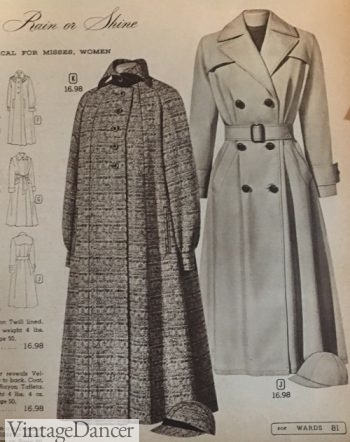
1956 trench and tweed box raincoats
Plastic rain covers were a returning style from the 1930s. Clear plastic as well as colored plastics (red, blue, yellow) were heat sealed into overcoats that were completely water repellent. They had attached hoods, a tie or elastic waist, and mid-shin-length. If I lived in a rain heavy area, I would wear these.
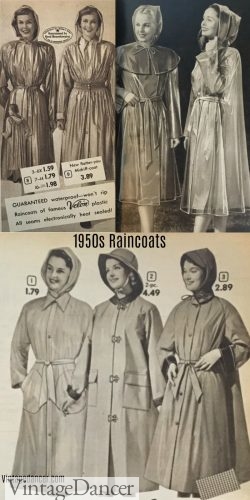
1950s Wrap coats and an oil slicker coat with matching rain bucket hats and tie under hoods with fold back brim (love those hoods!)
Other raincoat styles were made of all plastic such as the one above.
The button-down utility coat was still in style, too. Buttons were bigger and the length longer. Some were even double breasted. The straight fitting coat became more popular as the decade moved on. They were still cut wide enough to accommodate full skirts, but the non-belted waist repelled water better. They came in brighter colors (Hot pink! Turquoise!) and graphic patterns such as checks, houndstooth, polka dots, and small stripes. If the outside was plain, you could count on the inside lining featuring fun and cheerful prints.
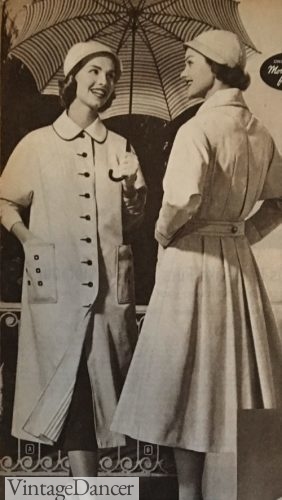
1950s button down utility raincoat with round collar, lined in blue candy stripes
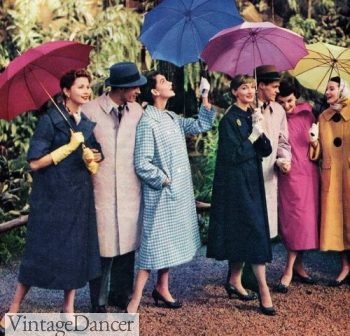
The late 1950s straight or tent-shaped raincoats and umbrellas
Vintage Umbrellas
What about rain umbrellas? They deserve an entire article of their own. Here is a sneak peek while I work on it:
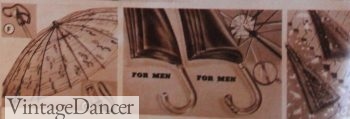
1930s (L)clear rain umbrella (M) umbrella with bakelite handles
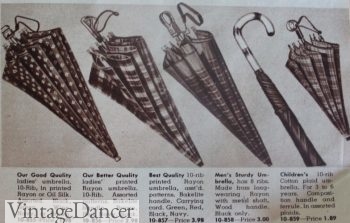
1940s plaid umbrellas
1950s umbrellas were long and slender, with wood or plastic handles and bold prints like candy stripes, plaid, and polka dots. They were primarily made of waterproof Rayon, Nylon or Acetate. Vedrenne, a French company, sold umbrellas with a handle that unscrewed in the middle so that the handle could match an outfit. The long black umbrella was especially trendy towards the end of the decade, when there was an Edwardian / Victorian revival. Handles could be straight, bob, or cane shaped with a chain strap. Outer shapes included the pagoda top, classic shade, walking umbrella (long pointy tip), and the small carriage type.
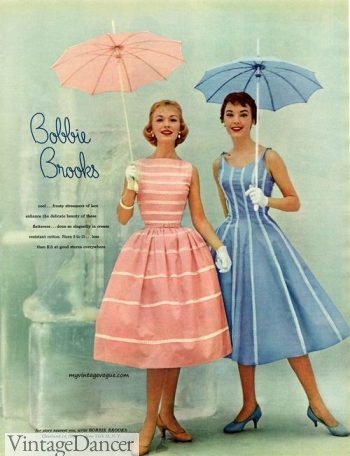
1956, small carriage umbrellas or parasols match Bobby Brooks dresses
Parasols made a comeback when Chinese inspired clothing and hats (coolie hat) made an appearance in the mid ’50s. Paper parasols and lacquer coated parasols sported traditional Asian prints as well as modern designs.
Fashion umbrellas reach new creative designs in the mid 50s. This video from 1956 shows umbrella and parasol fashions including umbrellas with fur trim, a music box handle, an all white lace or satin bridal parasol, and a ruched chiffon parasol. These were by no means practical for rainy weather — they were usually sold with a matching coat and accessories.
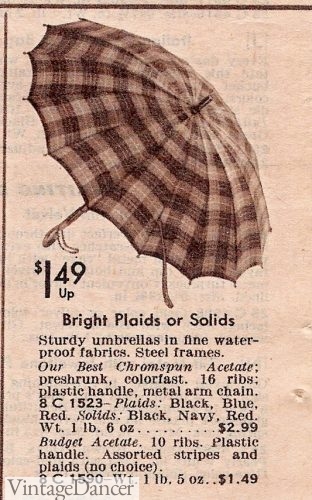
1957 plaid umbrella
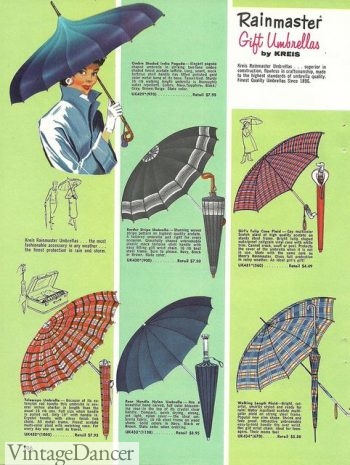
1950s Rainmaster umbrellas
Shop vintage coats and raincoats and umbrellas here.
Debbie Sessions has been teaching fashion history and helping people dress for vintage themed events since 2009. She has turned a hobby into VintageDancer.com with hundreds of well researched articles and hand picked links to vintage inspired clothing online. She aims to make dressing accurately (or not) an affordable option for all. Oh, and she dances too.